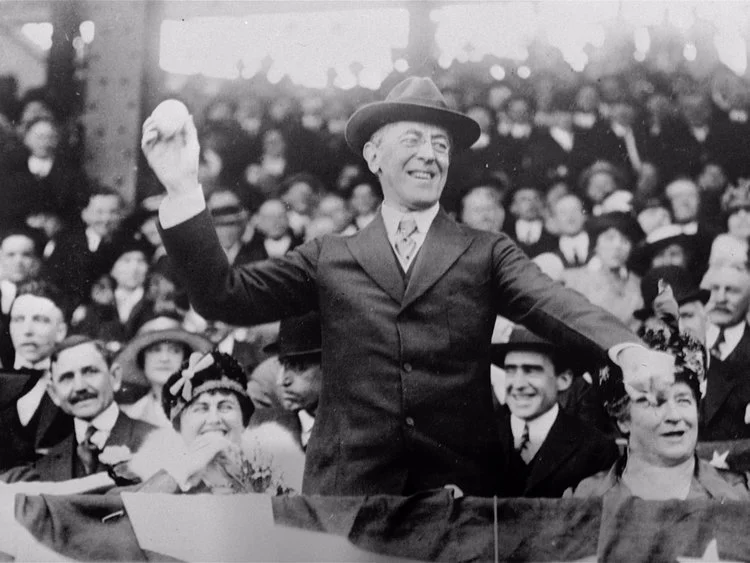President
During Woodrow Wilson's presidency...
Women received the right to vote with the passing of the 19th Ammendment.
The Federal Reserve System was established.
Income tax was initiated with the birth of the Internal Revenue System.
World War I broke out in Europe between 1914 and 1918.
Sheep grazed on the White House lawn to help the Red Cross raise wool for the war effort.
The national observance of Mother's Day was established.
Image is on the $100,000 bill although it is no longer in circulation
Woodrow Wilson was the first president to...
Personally deliver what is known today as the "State of the Union Address".
Hold regular news conferences.
Cross the Atlantic Ocean while in office.
Was the first president to attend the Major League Baseball Fall Classic. He saw the debut of a young 20 year old pitcher by the name of George Herman "Babe" Ruth.
Woodrow Wilson and the Great War
When Europe was thrust into war in 1914, Woodrow Wilson, who believed in neutrality, saw America's role as that of peace broker. "The Great War", as contemporaries called it, was without precedent, involving many countries in a vast and gruesome battlefield. The resumption of unrestricted submarine warfare by Germany and the news of the Zimmermann telegram were part of a long process that persuaded Wilson to ask for a declaration of war. Rarely does one event precipitate a decisive reaction from a thoughtful and deliberate individual such as Wilson. The Russian Revolution and the French Army mutiny convinced the United States that Russia and France would pull out of the war leaving the way open for a German victory. This was unacceptable to the Wilson administration. These two events, combined with the numerous sinking of ships, the increasingly belligerent communications from the Germans, the resumption of unrestricted submarine warfare, and the Zimmermann telegram, drove Wilson’s decision. In April 1917, Wilson asked Congress to declare war, only the second declaration of war in U.S. history. President Wilson was best remembered for his leadership during World War I and his vigorous attempt to establish the League of Nations. The war came to an end on November 11, 1918. At the Paris Peace Conference, Wilson proposed "Fourteen Points" as the basis for the peace treaty. The final Treaty of Versailles included many of Wilson's ideas. Unfortunately, the U.S. Congress did not support the Treaty. Consequently, the United States never joined the League of Nations. In 1920, Wilson was awarded the Nobel Peace Prize for his efforts on behalf of the League of Nations.
Visit the links listed below for an insightful journey into the history of The Great War.
World War I Links
Wilson - A Portait/America At War
The Great War
First World War
Liberty Memorial Museum
Lowell Thomas and Lawrence of Arabia
A President's Illness Kept Under Wraps: Woodrow Wilson's Deteriorating Health Detailed in Doctor's Correspondence
By Michael Alison Chandler
Washington Post Staff Writer
Washington Post Photo
Saturday, February 3, 2007
STAUNTON, Va. While U.S. troops were fighting in World War I in the summer of 1918, President Woodrow Wilson underwent treatment for a breathing problem in a hushed episode that foreshadowed worse health troubles to come.
The White House doctor, Cary T. Grayson, later recounted the incident to his wife in one of a slew of newly public documents that show how far Wilson's innermost circle went to conceal his frail condition amid major world events.
"The patient is progressing most satisfactorily, so far, and I have good reasons to hope for a most beneficial result. It has been a big undertaking. . . . No one knows anything about it except Miss E., Miss Harkins, Hoover -- It is one secret that has been kept quiet, so far, and I think it is safe all right now," the doctor wrote Alice Grayson in a July 16 telegram.
The episode, which caused Grayson great anxiety, most likely involved an operation to remove polyps from the president's nose, according to Michael Dickens, a Charlottesville physician familiar with Wilson's medical history and the telegram. Historians say the telegram indicates that the procedure was then known only to Grayson; the president's wife, Edith Wilson; a nurse; and a White House usher.
Grayson's account was revealed to the public recently through a cache of personal files his family donated to the Woodrow Wilson Presidential Library here in the Shenandoah Valley. The letters, photographs and other documents had been stored for decades at a family home in Fauquier County.
The papers offer new insight into the 28th president's fragile health and how those around him tried to keep it quiet. Although historians have known for years about Wilson's debilitating stroke in late 1919 and his poor health beforehand, including previous possible strokes, the estimated 10,000 documents in the Grayson collection offer fresh and intimate details about the president's mental and physical condition from a man whom several Wilson biographers call an extraordinary eyewitness: his personal physician.
"He literally had his finger on the pulse of the president," said historian A. Scott Berg, who has been studying the Grayson papers for a forthcoming Wilson biography. "Dr. Grayson enjoyed a unique position in Woodrow Wilson's life as both his personal physician and a personal friend."
The Grayson documents are the first major donation to the eight - year-old Wilson library, which unveiled them in late December on C-SPAN. The documents are drawing historians to this city two hours southwest of the Washington area where Wilson was born to a Presbyterian minister and his wife 150 years ago. Researchers say about 15 percent of the documents have been explored so far.
Grayson, born in Culpeper County in 1878 to a well-connected Virginia family, was a naval surgeon who rose to the rank of rear admiral.
At the family home in Upperville, Cary T. Grayson Jr. is surrounded by black-and-white photos of his father in an impeccable Navy uniform posing with his "number one patient," as the elder Grayson sometimes called the president. The younger Grayson, now 87, lives there with his wife, Priscilla. He said the papers reveal that the doctor-patient relationship was about much more than health.
In the doctor's weekly planners, now at the library, Grayson chronicled frequent golf games, automobile rides and nights of theater with the president. From inauguration day in 1913, when they met, to the Sunday morning in February 1924 when Wilson died, Grayson was an almost constant companion. He stayed often at the White House, traveled with Wilson to the Paris Peace Conference in 1919 and was one of a few people who saw him regularly after his stroke that October.
The stroke was a turning point for Wilson's presidency and, many argue, the world. Wilson collapsed Oct. 2 in the White House after a national tour seeking support for the Treaty of Versailles and America's entrance into the League of Nations. He went into seclusion for the remainder of his presidency. The treaty he had so strongly championed was rejected by the Senate in March 1920.
"This is the worst instance of presidential disability we've ever had," said John Milton Cooper, a Wilson scholar at the University of Wisconsin. "We stumbled along . . . without a fully functioning president" for a year and a half, he said.
The public was largely left in the dark about Wilson's condition. The official White House line was that the president was suffering from "nervous exhaustion." Other presidents have also concealed health problems, historians say, but the secrecy that enveloped Wilson's illness seems difficult to imagine today.
Grayson died in 1938. Years ago, his family gave Arthur S. Link, a preeminent Wilson scholar, access to his diary. Much of it was published in Link's collection of Wilson papers in the late 1980s and early 1990s, offering historians an in-depth look at the troubled end of Wilson's presidency and how his health could have affected major events.
Link's grandson is one of the historians now sifting through the Grayson papers to see what else they reveal about the president. Arthur Link III and other researchers were struck by this letter from Grayson to his wife dated Aug. 19, 1915: "
My number one patient in this house had an accident last night with one of his eyes -- the good one, which is bad now. I am hurrying off to Philadelphia with him at six o'clock tomorrow morning to consult an eye specialist. We are going by motor. I think we can make the trip less noticeable in this way -- . . . [T]he papers will read something like this: The President made his annual visit to the oculist etc etc."
The letter was written during Wilson's first term at a time when many historians believe he was relatively healthy. During Wilson's second term, Grayson wrote another letter to his wife Sept. 7, 1918, that may be of historical note. It appears to refer to a second operation, similar to the previous one that Grayson probably performed that year on Wilson's nose.
Researchers were also struck by two photographs that experts say show Wilson at his last Cabinet meeting in 1921. In one photo, he is holding a cane; in the other, the cane appears to have been erased.
"They were flying by the seat of their pants, doing damage control," Link said. "It's fun to watch."
Historians say the documents help shed light on what can happen when a president falls ill. The 25th Amendment spells out how a vice president can become acting president in the event of a presidential disability. But that amendment was ratified in 1967, nearly a half-century after Wilson left office.
A letter Grayson sent from Europe to his friend Samuel Ross on April 14, 1919, shows that Wilson's doctor knew the stakes:
"The president was suddenly taken violently sick with the influenza at a time when the whole of civilization seemed to be in the balance. And without him and his guidance Europe would certainly have turned to Bolshevism and anarchy. From your side of the water you can not realize on what thin ice European civilization has been skating. I just wish you could spend a day with me behind the scenes here. Some day perhaps I may be able to tell the world what a close call we had."
Now the papers are gone from the Grayson family basement, attic and closets. But Cary Grayson Jr. still has family stories to share. He recalled how his older brother Gordon went with their father to the White House to cheer the president after the 1919 stroke, sitting at Wilson's feet while they watched Western movies. Sometimes they went for drives with him.
Grayson himself had a stroke in August. He used a cane as he walked around the wooded hills where his father used to go fox hunting. He said he is relieved that the papers have a place in history.






